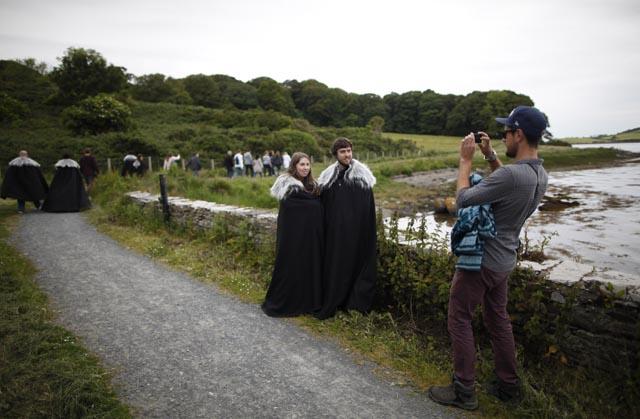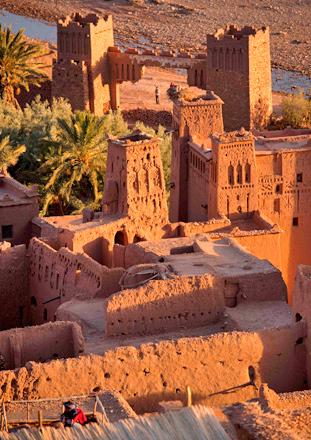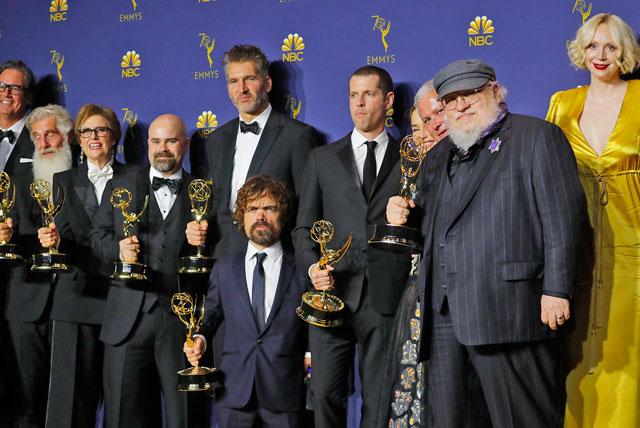You are here
‘Game of Thrones’ puts Northern Ireland on the map
By AP - Jun 22,2014 - Last updated at Jun 22,2014

BELFAST, Northern Ireland — Giants, dragons and vengeful queens have for generations populated Northern Ireland’s folk tales. Now, such creatures are visiting the land in a different version — on the sets for the hit TV show “Game of Thrones”. But rather than spells and destruction, they’re bringing an economic boost to this British province still healing from its past of political violence.
Fans of the HBO fantasy drama would recognize here the landscapes from the fictional land of Westeros — the castle of Winterfell, the seaside cliffs of the Iron Isles and the King’s Road leading to the north. About 75 per cent of the show is filmed in Northern Ireland, both in natural settings and in the Titanic Studios in Belfast.
Since the pilot episode began filming in 2009, attracted by the local government’s financial incentives, the show’s presence has helped foster a film industry that is catching the eye of other Hollywood productions. And Northern Ireland is taking advantage of the attention by promoting the filming locations as tourist destinations.
The latest — and perhaps most illustrious — visitor is Queen Elizabeth II, who will tour the studio sets on Monday. But thousands have already been visiting from across the globe.
Cara and Tom Collins from Springdale, Arkansas, were in Ballintoy Harbour recently to see the rocky coastal setting used in the show for the “Iron Isles”, a kingdom of rugged sailors.
“You can just close your eyes and picture everybody there,” said Tom.
The season four finale of “Game of Thrones” last week was watched by 7.09 million viewers in the United States according to prime-time viewership numbers complied by the Nielson Co. That makes it HBO’s most-watched programme since “The Sopranos” in 2007.
But the numbers are likely higher since TV audience habits have changed since 2007 and “Game of Thrones” has fans globally who watch on local networks and via DVD or streaming services.
For Northern Ireland’s tourism industry, that represents a huge pool of potential visitors. The province hopes to use the show’s popularity to increase the number of tourists to over 2 million annually by 2016, from 1.8 million in 2013 — more than the region’s population of just 1.8 million.
Coach operators have created “Game of Thrones” tours, for which demand hit a record as the show reached its season finale this month.
“They are using some of our most iconic scenery in ‘Game of Thrones’ which is excellent,” said Arlene Foster, minister for enterprise, trade and investment.
Beyond tourism, the direct employment of local workers has been very important for the local economy, she said.
At the end of series four, HBO is estimated to have spent about £87.6 million ($149.11 million) in the local economy making the show. The benefits are likely much higher when including other factors, such as the knock-on benefits from higher employment.
“This is a sector that we think has the potential to really grow,” said Foster. “Around the HBO facility and studios will grow a skills base that others can use.”
Holywood — pronounced the same as California’s “Hollywood” — is a small seaside town near Belfast that may lack the glamour of Beverly Hills, but is gaining a movie-making reputation of its own. Yellow Moon, a production facility based there, has enjoyed strong growth and doubled its workforce by being involved with “Game of Thrones”.
“HBO were a big catalyst in changing perceptions of what could be done in Northern Ireland. As the Americans say, it was a game changer,” said Managing Director Greg Darby.
Five years ago, 80 per cent of Yellow Moon’s work was for local broadcasters, and just 20 per cent for productions based in the UK or further afield. Now, 70 per cent of their work is commissioned outside Northern Ireland.
“’Game of Thrones’ are directly or indirectly responsible for 80 per cent of the people that we have taken on in the last three years, because if they didn’t come we wouldn’t have the other work,” said Darby.
Scott Ferguson’s story illustrates what “Game of Thrones” means for young creative people in Northern Ireland.
He dreamt of being a film editor, but his first experience in the industry failed to lead to more work, so he took a job in a bank. Then five years ago a government training scheme lead to a placement at Yellow Moon and he is now a colourist on the show, adding mood and tone to the images in post-production, and on his way to becoming an expert in his field.
Ferguson is confident that people like him will no longer need to emigrate to seek work in film and TV, now that Northern Ireland’s reputation as a production hub is growing.
“We have world class facilities, and we now have a world class crew. We have a shooting crew and we have a post crew who have worked on the biggest, most watched, most successful TV show that has been around for a while,” he said.
Related Articles
AIT-BEN-HADDOU, Morocco — Millions worldwide may have seen the desert fortress in the hit fantasy series “Game of Thrones”, but fewer know t
LOS ANGELES — The divisive final season of “Game of Thrones” smashed the record for most Primetime Emmy nominations by a drama series in a s
LOS ANGELES — HBO’s record-breaking fantasy epic “Game of Thrones” stormed back onto the Emmys stage on Monday, winning the coveted best dra


















